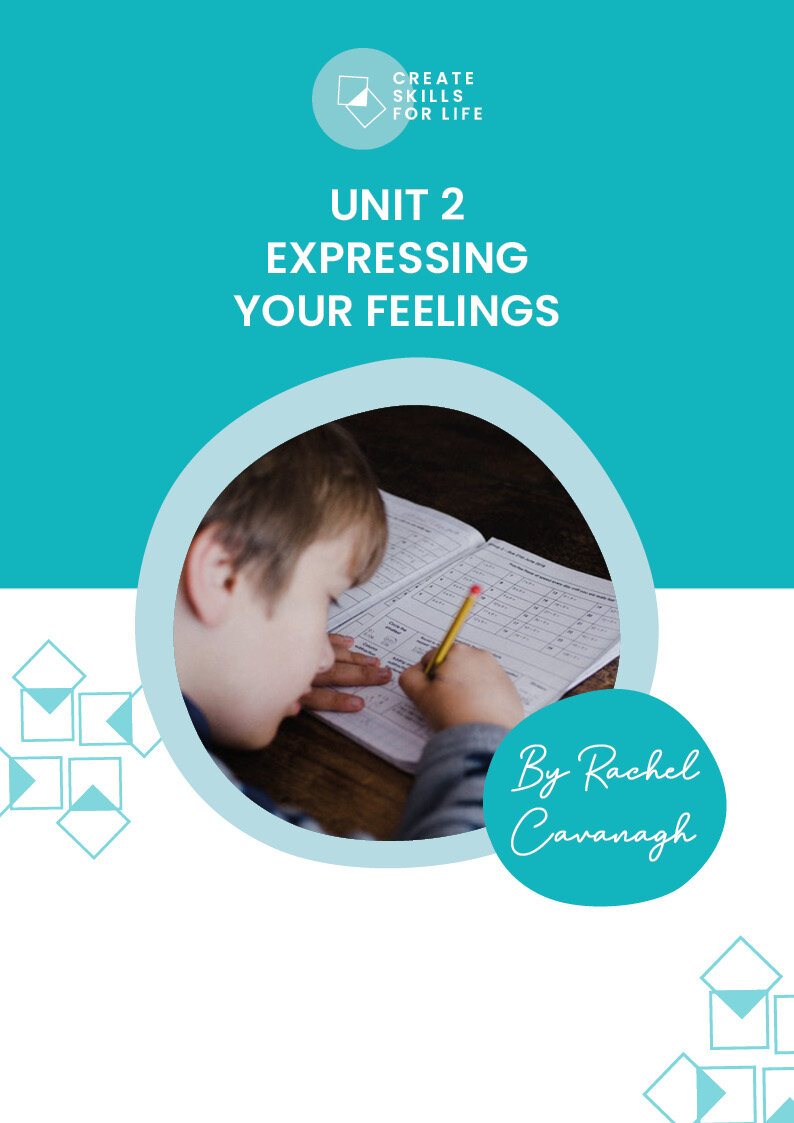 Image 1 of
Image 1 of


Skills Manual Unit Two Bundle for Teachers and Therapists
Expressing your feelings
Unit 2 focusses on making deeper observations of self to create self-regulation. Students are taught how to know their own face and body; this can help identify and understand emotions and how to regulate them. This unit builds on the scaffolds from Unit 1 creating more articulation of facial expression, the body and feelings. Exploration of how these elements link and interact with each other takes place.
Language, which articulates these emotions, thoughts and feelings on the face and in the body, is explored. A range of visual representations is offered to approach this topic. Matching, comparing, ranking, labelling and mapping are methods used to encourage and practice this emerging language.
The concept of deciphering between ‘like’ and ‘love’ is explored to contextualise ‘others’ within relationships. Learning centres on deciphering the closeness of relationships and how to create order and make sense of one’s own world. The learner is explicitly introduced to the language and customs used in close relationships and how to use describing as a method of communication.
Choices and making decisions are explored in this unit. Knowledge of self and understanding of what is liked and disliked is developed, which then can be communicated with others.
The important skill of observation is initiated in this unit. This skill is later developed into analysis and interpretation of others. At this early stage it is all about looking and finding, opening the awareness and finding things outside of self.
Dominoes, from Lesson 2, works on the ‘knock-on effect’ and introduces how actions can occur as a series of events. This unit does not rely solely on verbal activities but demonstrates and uses the process of visual recall by using words such as ‘knock on’; a combination of visual based learning utilising recall with concrete learning materials.
Expressing your feelings
Unit 2 focusses on making deeper observations of self to create self-regulation. Students are taught how to know their own face and body; this can help identify and understand emotions and how to regulate them. This unit builds on the scaffolds from Unit 1 creating more articulation of facial expression, the body and feelings. Exploration of how these elements link and interact with each other takes place.
Language, which articulates these emotions, thoughts and feelings on the face and in the body, is explored. A range of visual representations is offered to approach this topic. Matching, comparing, ranking, labelling and mapping are methods used to encourage and practice this emerging language.
The concept of deciphering between ‘like’ and ‘love’ is explored to contextualise ‘others’ within relationships. Learning centres on deciphering the closeness of relationships and how to create order and make sense of one’s own world. The learner is explicitly introduced to the language and customs used in close relationships and how to use describing as a method of communication.
Choices and making decisions are explored in this unit. Knowledge of self and understanding of what is liked and disliked is developed, which then can be communicated with others.
The important skill of observation is initiated in this unit. This skill is later developed into analysis and interpretation of others. At this early stage it is all about looking and finding, opening the awareness and finding things outside of self.
Dominoes, from Lesson 2, works on the ‘knock-on effect’ and introduces how actions can occur as a series of events. This unit does not rely solely on verbal activities but demonstrates and uses the process of visual recall by using words such as ‘knock on’; a combination of visual based learning utilising recall with concrete learning materials.
Expressing your feelings
Unit 2 focusses on making deeper observations of self to create self-regulation. Students are taught how to know their own face and body; this can help identify and understand emotions and how to regulate them. This unit builds on the scaffolds from Unit 1 creating more articulation of facial expression, the body and feelings. Exploration of how these elements link and interact with each other takes place.
Language, which articulates these emotions, thoughts and feelings on the face and in the body, is explored. A range of visual representations is offered to approach this topic. Matching, comparing, ranking, labelling and mapping are methods used to encourage and practice this emerging language.
The concept of deciphering between ‘like’ and ‘love’ is explored to contextualise ‘others’ within relationships. Learning centres on deciphering the closeness of relationships and how to create order and make sense of one’s own world. The learner is explicitly introduced to the language and customs used in close relationships and how to use describing as a method of communication.
Choices and making decisions are explored in this unit. Knowledge of self and understanding of what is liked and disliked is developed, which then can be communicated with others.
The important skill of observation is initiated in this unit. This skill is later developed into analysis and interpretation of others. At this early stage it is all about looking and finding, opening the awareness and finding things outside of self.
Dominoes, from Lesson 2, works on the ‘knock-on effect’ and introduces how actions can occur as a series of events. This unit does not rely solely on verbal activities but demonstrates and uses the process of visual recall by using words such as ‘knock on’; a combination of visual based learning utilising recall with concrete learning materials.
